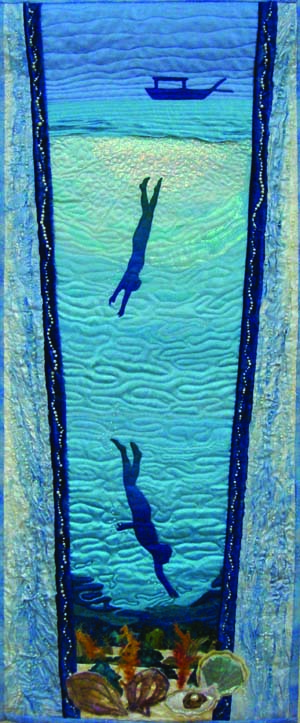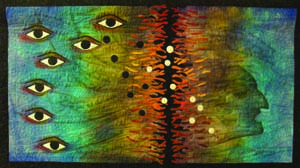|
I was delighted, during a visit to York in May, to discover that the Quilt Museum and Gallery in York (situated in the 15th century guildhall, St. Anthony’s Hall) was holding an exhibition on the theme of ‘Pearls, Pearls, Pearls’. The quilts were designed and made by members of The Quilters’ Guild of the British Isles who were invited to submit a new piece of quilted work to celebrate The Guild’s 30th (i.e. Pearl) anniversary. The Quilters’ Guild of the British Isles is a national membership organization, which was formed in 1979 and is made up of about 7,000 individual members, mostly from the UK, but also from Europe and other parts of the world. The Guild is an Educational Charity, which provides educational resources and services for its members, lends support to teachers within the Guild and liaises with educational bodies beyond the quilting world. Membership is open to anyone who works in patchwork, quilting or appliqué or has a special interest in quilts. The pieces chosen for the exhibition demonstrated a wide interpretation of the ‘Pearls, Pearls, Pearls’ theme. The designs encompassed a range of contemporary, pictorial and traditional styles. The techniques used included appliqué, both hand and machine quilting, together with the use of stencils and fabric painting. The materials utilised included hand dyed, digitally printed and commercial fabrics, tissue paper, felt and feathers and of course much embellishment with beads and pearls. The exhibits varied in size and were mainly wall hangings; the largest being 140cmx140cm and the smallest 32cm x 46cm, but also included quilted garments, a soft furnishing and a 3D piece. There was a good mix of entries from both professional and non professional quilters who are all members of the Quilters’ Guild. In her book ‘Oyster’, Rebecca Stott comments that pearls rarely appear along with oysters in western art. However, among the many inspiring exhibits I have selected items which explored more explicitly the “shell” theme in their designs. I have also used extracts from descriptions by the designers themselves which were included in the exhibition guide. In earlier times, before the era of modern science and natural history, many legends surrounded the pearl oyster. Early Greek and Roman writers thought that pearls were formed when oysters migrated to the surface of the sea, opening their valves to obtain drops of dew and then returning to the sea bed where the dew was transformed into pearls (figure1). The pearl is, in reality, a by-product of certain molluscs evolving a way of protecting their body from the roughness of the shell by secreting a smooth nacreous lining, also known as mother-of-pearl. Pearls occur when a foreign particle that has entered the shell is coated by layers of nacreous secretion, in order to reduce irritation. Thus the iridescent pearl is formed - a mixture of calcium carbonate and an animal substance called conchiolin (Figure 2). Pearls are not only white, as Osias Beert and Jan Vermeer noted: ‘the whites of wet oyster flesh, of mother of pearl and of pearls were never just white’ .....No two pearls are the same for each is made from the mother-of-pearl lining produced by a particular place. Mother-of-pearl can be pink, rose, white, yellow, cream, golden, green, blue and black (Figure 3). The pearl industry has a long history. For example pearls were collected in the Persian Gulf as long ago as the second millennium BC. An inscription in cuneiform from the ancient Assyrian city of Ninevah details a king’s interest in ‘the sea of changeable winds’ where his merchants fished for pearls. Methods of diving for oysters have changed surprisingly little throughout the centuries. Since the end of the time of enslavement of the pearl divers, these men and women have inspired enormous respect from their own communities for the skill, courage and risk they undertook (See figure 4). Pearls have been a part of culture since the 6th century BC and pearl necklaces are described in the ancient Hindu religious poem, the ‘Ramayana’ written about 500BC (See figure 5). However, when eventually in the 19th century developments in oyster farming and transportation led to a drop in the market price of oysters which turned them into the food of the poor, the pearl also began to change it’s status of exclusivity. For many centuries pearls had been worn by the wealthy and powerful. But in the 19th century, mass production techniques of pearl buttons made possible by the Industrial Revolution enabled the very poor to mimic and even subvert the use of pearl as a marker of wealth. Pearl buttons, carved out of the mother-of-pearl lining of the oyster shells by new cutting machines, were striking but relatively easy to produce. In 1875, Henry Croft, a municipal road sweeper, collected the pearl buttons that had fallen to the market floor from the clothes of costermongers, stitching each by hand onto his own clothing until every inch of cloth had been covered. Dressed in this suit he collected money for hospitals, orphanages and workhouses in the slums of London; this became the origin of the London ‘Pearly Kings and Queens’ (See figure 6) Lastly, figure 7. This particular quilt summed up all that is beautiful and enduring about a pearl, conveying a sense of the power of art to transform the ‘ordinary stuff of life into something beautiful and enduring and rich and strange’. References ‘Pearls, Pearls, Pearls,’ exhibition guide (Quilters’ Guild of the British Isles, 2009) Scott, Rebecca ,’Oyster’ (Reaktion Books, London, 2004) Acknowledgements Images and descriptions from the exhibition are published with the kind permission of the artists themselves and of the Quilters’ Guild of the British Isles. Particular thanks are due to Fiona Diaper, Museum Director of the Quilt Gallery and Museum, York, for proof reading this article prior to publication and liasing with the quilters concerned. |
(All photos by Peter Topley) |
Pearls, Pearls, Pearls: a Quilting Exhibition
Issue
21
Page
12

 Figure 1: ‘Pearls from Moonlight’ by Jane Edmonds, Beaconsfield, Bucks. Her quilt was “inspired by Greek and Roman legends that pearls are formed when dewdrops filled with moonlight fall into the ocean and are swallowed by seashells.”
Figure 1: ‘Pearls from Moonlight’ by Jane Edmonds, Beaconsfield, Bucks. Her quilt was “inspired by Greek and Roman legends that pearls are formed when dewdrops filled with moonlight fall into the ocean and are swallowed by seashells.” Figure 2: ‘The home of the pearl.’ By Chris Dixon, Gosforth, Newcastle.‘The design is developed and stylised from an oyster shell drawing. I have described the rough ribbed and textured nature of the oyster shell, a contrast to the smooth contained pearl inside.’
Figure 2: ‘The home of the pearl.’ By Chris Dixon, Gosforth, Newcastle.‘The design is developed and stylised from an oyster shell drawing. I have described the rough ribbed and textured nature of the oyster shell, a contrast to the smooth contained pearl inside.’ Figure 3: ‘Pearls are not just white’ By Liz Heywood, Chandler’s Ford, Hants. ‘Quilt inspired by the contrast between the rough outside rim of the oyster shell and the smooth lustrous interior where the pearl is found.’
Figure 3: ‘Pearls are not just white’ By Liz Heywood, Chandler’s Ford, Hants. ‘Quilt inspired by the contrast between the rough outside rim of the oyster shell and the smooth lustrous interior where the pearl is found.’ Figure 4: ‘Pearl Divers’ by Penny Armitage, West Horsley, Surrey. ’My quest to capture light on the sea goes underwater along with oysters, divers and my textured textiles and a wonderful excuse to collect pearl beads.’
Figure 4: ‘Pearl Divers’ by Penny Armitage, West Horsley, Surrey. ’My quest to capture light on the sea goes underwater along with oysters, divers and my textured textiles and a wonderful excuse to collect pearl beads.’ Figure 5: ‘Pearl Necklace’ by Pam Stanier, Malvern Wells. ‘Pearls, pearls, pearls, made me think of a pearl necklace casually thrown onto a patchwork quilt.’
Figure 5: ‘Pearl Necklace’ by Pam Stanier, Malvern Wells. ‘Pearls, pearls, pearls, made me think of a pearl necklace casually thrown onto a patchwork quilt.’ Figure 6: ‘Pearls. Pearlies, Pearlies’ by Pat Salmon, Leatherhead, Surrey ‘Young Pearly King and Queen against a background of Lambeth walk.’
Figure 6: ‘Pearls. Pearlies, Pearlies’ by Pat Salmon, Leatherhead, Surrey ‘Young Pearly King and Queen against a background of Lambeth walk.’ Figure 7: ‘Full Fathom Five’ by Anne Tuck, Gosforth, Newcastle. ‘Those are pearls that were his eyes..Nothing of him.. but doth suffer a seas change’ Words spoken by Shakespear’s sprite Ariel.
Figure 7: ‘Full Fathom Five’ by Anne Tuck, Gosforth, Newcastle. ‘Those are pearls that were his eyes..Nothing of him.. but doth suffer a seas change’ Words spoken by Shakespear’s sprite Ariel.